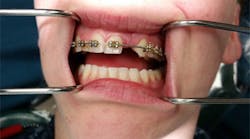Implant site development and limited orthodontics
Implant site development can be a complicated endeavor, involving a skill set that includes proficiency in various bone grafting techniques, soft-tissue augmentation, sinus grafts, and specialty ridge procedures. Regardless of the procedure, the goal is the same: to make the site ready for an implant from the perspective of well-studied bone and tissue requirements.(1) But what about space requirements?
For many patients, convenience is king, and the value of having the same dentist throughout multi-disciplinary dental care cannot be underestimated. So if a patient is challenged with insufficient mesial-distal width or a simple malocclusion that prevents the progression of implant treatment, what is a dentist to do? The general practitioner should consider limited orthodontic treatment, also known as minor tooth movement. This particular specialty is problem focused and allows general practitioners the ability to optimize an implant surgical site and expedite treatment, all in-house!
Implant therapy aside, most general dentists know that patients who present with complicated orthodontic problems, including open bites, significant cross bites, and dual-arch treatment, should be referred to orthodontists. I follow a simple guideline—when in doubt, refer. But it has been my experience that additional space in a mesial-distal direction or the correction of minor tooth discrepancies can be accomplished with limited orthodontic treatment.
What constitutes limited orthodontic treatment and how can it be incorporated into your implant practice? Limited orthodontic treatment, as defined by the American Academy of Orthodontics (AAO), “typically focuses on limited objectives, not necessarily including the entire dentition. It may be directed at the only existing problem, or at only one aspect of a larger problem in which a decision is made to defer or forego a more comprehensive plan of therapy.”(2)
Traditional applications of limited orthodontics, including diastema closure, molar uprighting, and the correction of simple malocclusion, can by themselves be used to help gain additional implant space. The practice of enamel stripping, coil springs, and power chains are also important in optimizing the space requirements of an implant surgical site.
How many teeth comprise limited orthodontic movement? I am asked this question frequently and there is no absolute number of teeth, it is case dependent. Guidance on a quantitative definition of limited orthodontic treatment, i.e., how many treated teeth comprise limited orthodontic treatment, is not included in the AAO definition.
General dentists practicing limited orthodontic treatment should be clinically familiar with basic orthodontic armamentarium and processes, understand fundamental tooth movement biomechanics, and be knowledgeable about current orthodontic practices with regards to retention. Enamel stripping is a frequent technique of gaining additional space, and the practitioner should be comfortable performing this procedure, either with diamond strips, burrs, or discs.(3) I would estimate that the average treatment time for my patients receiving limited orthodontic treatment for the purpose of follow-on implant therapy to be anywhere from two to five months.
For those general practitioners wanting to incorporate orthodontic movement in their practices, an effective partnership with local orthodontists is a great place to start. Many of these specialists are eager to share their knowledge and may even refer patients to you for minor movement! Incorporating limited orthodontic treatment into your practice is not difficult. But it is important to remember that general practitioners will be held to the same standard of care as specialists. For this reason, general practitioners should seek out training and continuing education with such long-standing organizations as the American Orthodontic Society, the Academy of GP Orthodontics, and other general practitioner-focused orthodontic training programs.
More general dentists are increasing the scope of their implant practices to include implant fixture placement through final restoration. General dentists should also consider incorporating limited orthodontics into their implant practices. Minor tooth movement can allow dentists to keep treatment in-house and can afford patients the benefits of continuity of care. With additional training and continuing education, general dentists can apply limited orthodontic treatment to help maximize implant surgical sites and expedite implant therapy.
This article first appeared in DE's Expert Tips & Tricks. To receive enlightening and helpful practice management articles in this e-newsletter twice a month, visit dentistryiq.com/subscribe.
References
1.Tarnow DP, Cho SC, Wallace SS. The Effect of inter-implant distance on the height of inter-implant bone crest. J periodontal. 2000; 71:546-549.
2. 2012 American Association of Orthodontists Glossary of Terms.
3. Livas C, Jongsma AC, Ren Y. Enamel Reduction Techniques in Orthodontics: A Literature Review Open Dent J. 2013; 7:146-151.
Brendan W. Tully, DDS, is a graduate of the University of Southern California School of Dentistry and an active duty US Navy Commander. He completed a general practice residency with the Navy and graduated from the US Army’s two-year comprehensive dentistry program at Fort Hood, Texas. He is a veteran of both Operation Desert Storm and Operation Iraqi Freedom. He can be reached at [email protected]. Dr. Tully reports no disclosures.

